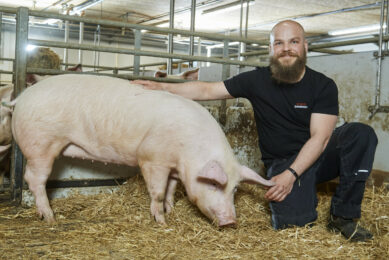UK: Two-Tonne Sow (2TS) gets the spotlight

The British pig industry has taken another step on its road towards achieving an average of 2,000kg of pig meat a sow a year by 2013 – the so-called Two-Tonne Sow (2TS) – with seminars on breeding and reproduction management.
©Held during October, these well-attended events featured in-depth updates on the latest techniques and question & answer sessions with international experts Prof Bas Kemp and Dr Nicoline Soede, from the animal science department at Wageningen University, and Dr Hanneke Feitsma, from IPG in the Netherlands.
©
Focusing on inseminations strategies, Dr Soede took time to explain the fertilisation process and the reasons why it was important to inseminate between 0 and 24 hours before ovulation, but not to wait until late oestrus to
achieve optimum results.
©
In a second paper on stress and reproduction, she pointed out that the reproduction process started in the brain, so sows should be kept as calm as possible from service until after farrowing for the best breeding results.
The critical period, however, was from day seven to day 21 when producers should be particularly careful not to cause unnecessary stress to pigs.
©
“Trials have shown that gentle handling and good husbandry practices will improve productivity. Reproductive performance appears to be high on farms where sows show little fear of humans, while on farms where the sows are fearful of humans, reproduction performance is lower,” Dr Soede said.
©
Dr Feitsma, meanwhile, discussed future AI technologies and explained how developments in extending shelf life of semen and new low-dose insemination, as well as sex-sorting semen could one day be helping producers to both improve production and save money.
©
However, to be effective and of use to producers looking to boost production, she stressed they would have to be simple, safe and provide satisfying results.
Prof Kemp explained why gilt management was so important and alerted the producers to what he described as “second litter drop syndrome” where some sows produced fewer piglets in the second litter.
©
He pointed out that the farrowing rate of sows tended to fall along with weight loss during the lactation period and that influenced litter size. So, it was important to stimulate feed intake during the first pregnancy.
©
It was also important to ensure that the sows avoided weight loss during lactation. As this could have a negative effect on the second litter
His take-home messages included:
©
- Gilts should be stimulated to grow sufficiently between first insemination and first weaning
- Lactation management is crucial to prevent excessive weight loss
- ©Repair of second litter syndrome is possible after weaning by either waiting for the second heat after weaning to inseminate, or by using progesterone analogue to improve fertility.
©
Speaking afterwards, Dr Mike Varley, head of knowledge transfer, research and development at the British Pig Executive (BPEX), explained the October events were part of a planned campaign over the next two years to help UK producers increase their production.
©
“We will be organising more meetings with overseas experts coming here to advise us on farrowing, weaner production and growers and finishers during the coming 24 months,” he added.
©
Photo:©Some of the many English producers at the seminar on breeding and pig reproduction at Milton Keynes recently.
©
(By Roger Abbott)
©











